TheRoundup is reader supported. We may earn a small commission when you make a purchase via links on this site, at no cost to you.
All products are personally reviewed and tested in accordance with our Review Methodology.

A non-toxic yoga mat is vital if you're concerned about the dangers of plastic, PVC, VOCs, phthalates, and other harmful chemicals
When I started my yoga journey, I was shocked to learn that most traditional mats are made from petroleum-based synthetic rubber.
That's why I made it my mission to find, test, and review the top eco-friendly yoga mats made from all-natural and sustainable materials.
After months of testing and research, I found some amazing thick, absorbent, and non-slip mats made from natural rubber, organic cotton, cork, jute, and grass fiber.
This guide will help you find a sustainable yoga mat that offers the grip and support you need for your daily practice, without harming your health or the environment.

✔ Excellent Grip
✔ 100% Sustainable Materials
✔ Non-Toxic & Biodegradable

Why It's My #1 Pick: The Jade Harmony Yoga Mat is highly regarded for its durability, superior grip and stability. It's ethically made from all natural materials, with no PVC, EVA, or other synthetics.
Personal Experience: As soon as I began to test the Jade Harmony and move through various poses, its excellent grip and stability were immediately evident. It did a great job preventing any slipping, even in the sweatiest of sessions.
The Harmony is 3/16” thick and provides comfortable cushioning and support during prolonged poses. If you have particularly sensitive knees, you might prefer thicker mats. But for most yoga enthusiasts, I think the Harmony mat strikes a nice balance between comfort and support.
It has a very mild natural rubber scent that is evident at first but not overpowering. While it carries a bit more weight than other mats, this heft is beneficial in keeping the mat grounded during your home or studio sessions.
Durability is a standout feature of this mat, with no visible signs of wear after frequent use. The color also stays vibrant over time, and the rubber scent diminishes, leaving you with just the essence of your practice environment.
The Harmony mat is made from biodegradable rubber, and with each purchase, Jade Yoga commits to planting a tree and donating to cancer or autism causes.
With the perfect combination of performance and responsibility, this eco-friendly yoga mat is my top recommendation and the one I still use most frequently today

✔ Moisture Wicking
✔ Very Light to Carry
✔ Free Yoga Classes Included

Why It's Good for Travel: The Mikkoa travel mat is incredibly lightweight (2 lbs), which makes it by far the lightest yoga mat I tested. It's easy to carry around, and you can fold it up small in any medium to large-sized bag.
Personal Experience: The Mikkoa Travel Mat makes it easy to enjoy your yoga practice on the go.
It’s made from natural rubber and vegan microfiber, so the eco-credentials are on point. But this doesn't come at the expense of quality, which is excellent.
It’s also moisture-wicking and machine-washable, so you can easily keep your mat clean and fresh.
As an added, bonus, free online yoga classes are included. I prefer the Peloton yoga classes, but these free ones are an excellent introduction to the world of online yoga if you’re a newbie.
The grip on this mat is first-rate. It simply didn't move, no matter how sweaty I got!
The portable nature of this mat means it’s slightly thinner than average and might not be suitable for those who need extra body support for issues like bad knees.
I’ve been really impressed with the eco-credentials of company founders Viv & Zoe and I'm excited to see what other products they come up with next.

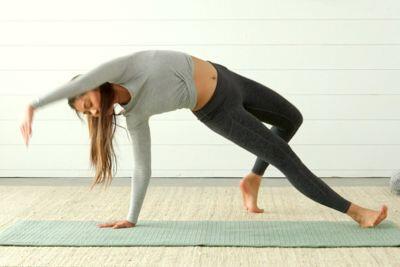
Why I Recommend It: Brentwood Home have created a fantastic GOTS-certified organic cotton yoga mat with a natural latex non-slip base. No other brand has managed to create a certified organic cotton mat of this quality.
Personal Experience: This is the mat I’ve owned for the longest time, and it still looks and performs like new.
It’s been my go-to mat ever since I discovered Brentwood Home sold yoga products while working on my overall Brentwood Home review.
I do tend to sweat a lot during practice and usually get through a bunch of towels when exercising. So an organic cotton mat with a non-slip surface ticks a lot of boxes for me.
These organic yoga mats actually double as a towel. They are excellent at soaking up the sweat. In fact, I find mine gets grippier as it gets sweatier.
It dries well and doesn’t smell too quickly. When it does get whiffy, I just pop it in the washing machine with our towels and then air dry it.

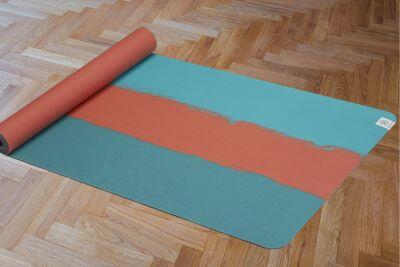
Why I Recommend It: The Gaiam Power Grip mat has a textured feel and super strong grip that make it perfect for warm and hot yoga. Once unrolled it simply doesn't move no matter what exercise you do on it.
Personal Experience: The Gaiam yoga mat was the first mat I tested, and it’s remained one of my favorites.
It's a 100% natural rubber mat, and the grip levels are incredible.
If I’m being picky, I would say that maybe it could do with being one or two mm thicker to help protect my dodgy knees. But most users find the thickness to be ideal.
Some customers have reported shredding issues, but I’ve used this mat heavily for months with no issues as yet.
Gaiam also provides a lifetime warranty, so if you’re unlucky enough to experience some shedding of the rubber, Gaiam will replace it for you free of charge.
This rubber yoga mat did give off a strong odor for the first day or two. This is a normal, harmless smell and soon goes away. Simply open and leave to air in the garage for a few days before first use.

✔ Excellent Grip and Cushioning
✔ Does not Absorb Dirt or Bacteria
✔ Closed Loop - Fully Recyclable
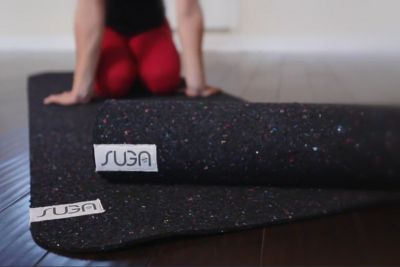
Why I Recommend It: SUGA mats are the ultimate recycled yoga mats, made in the USA entirely from recycled materials - in this case, old wetsuits. Every mat is also fully recyclable, and you can return it to SUGA for recycling when it reaches the end of its life.
Personal Experience: I wanted to test an upcycled yoga mat that really makes a difference, and in the SUGA mat I found exactly what I was looking for.
Neoprene wetsuits are normally not biodegradable, meaning surfers face an environmental challenge of how to properly dispose of them.
SUGA solves this problem by converting them into a closed-cell foam, which is a perfect material for eco-friendly mats because it doesn't absorb bacteria and dirt from the floor like conventional mats do.
I found that the SUGA mat has excellent traction and is completely non-slip (even for people like me who sweat a lot). It felt thick and soft enough to provide the extra support and cushioning that is essential for high-compression poses.
In my tests, I found it rolled out perfectly flat each time, dried quickly (as you'd expect a former wetsuit to do), and offered exceptional comfort and performance.

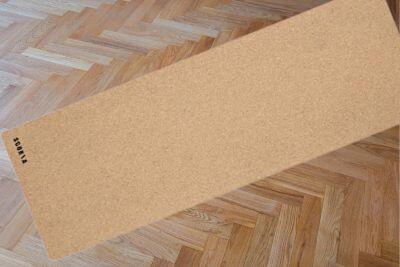
Why I Recommend It: This sustainably harvested natural cork mat is backed with an anti-slip 100% natural rubber base and is thicket than average for extra support. It comes in plastic-free, recyclable packaging.
Personal Experience: The Scoria Cork mat offers a 6mm thickness and anti-microbial cork surface, both of which I like, as I appreciate the extra cushioning for my knees.
However, the thickness of these cork mats might be too much for those who like to feel grounded.
Scoria also has you covered if you require less padding. They also do cork yoga mats at 2mm and 4.5mm thick.
Earth Hero offers free shipping on orders over $75.
Scoria supports Right to Play (an organization that empowers Indigenous youth through play-based education) by donating a portion of each sale.

✔ Biodegradable
✔ Zero-waste Manufacturing Process
✔ Grippy Closed-Cell Surface
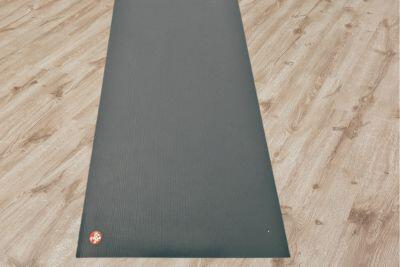
Why I Recommend It: Manduka is a brand that has been trusted by yoga teachers and students for many years. Their regular mats are made from PVC, but they recently developed this more environmentally friendly range called eKO that's biodegradable and made from eco-friendly materials.
Personal Experience: The Manduka eKO mat is made from biodegradable tree rubber with chemical-free foaming agents and non-azo dyes. No PVC or other harmful plasticizers are used.
Manduka is committed to a zero-waste manufacturing process. All post-industrial scrap is collected and used to produce other products and materials.
It's thick, sturdy, and very grippy, and the closed-cell surface structure means that sweat can not penetrate the mat as easily.
This means that while the Manduka eKO yoga mat will last a long time, it might need a short ‘breaking in’ period to allow the structure to soften up slightly.
But, once broken in, you’ll find that this is one seriously sticky yoga mat that will keep your body stable in any pose.

✔ Relaxing Scent
✔ Traditionally Handwoven in India
✔ Carbon Offset Shipping
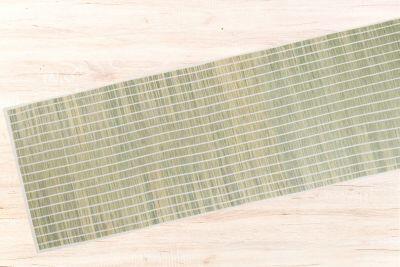
Why I Recommend It: This beautiful YogaKargha mat is handmade from a tropical grass called Darbha (recommended by Lord Krishna himself, no less!) and organic cotton.
Personal Experience: When I first unrolled this mat, I was hit with a lovely calming smell that immediately took me to a zen place.
The non-slip qualities of this product are excellent.
However, it’s not the most padded mat. If, like me, your knees/hips/elbows need a bit of extra help and TLC, this might not be the mat for you.
This mat is handmade in India and then shipped directly to you. This means that delivery can be rather slow. This product arrives around 18 days after orders are placed, in my experience.
It's well worth the wait, though, for a traditionally made, zero-waste mat.
You don’t even need to worry about the environmental impact of shipping this product halfway across the world from India. Etsy will buy credits on your behalf to carbon offset the emissions of the shipping and packaging of your YogaKargha orders.

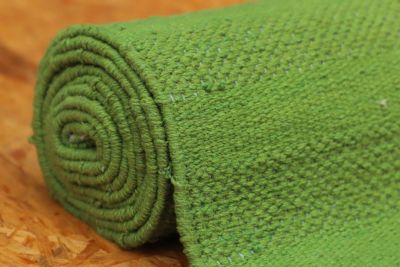
Why I Recommend It: This is another beautiful organic yoga mat from YogaKargha, handmade in India from the finest quality organic cotton. It's thicker and more forgiving on your joints than the Darbha mat, and comes with an optional rubber backing to prevent slipping.
Personal Experience: I was impressed by the Amrit mat, it absorbs sweat like a sponge, and is washable too! This is another excellent mat from YogaKargha.
Without the backing, it’s easier to wash the mat in your washing machine. With the backing, the mat is fully non-slip.
Either way, it's a non-fussy, basic design that is classically understated. Ideal for hot yoga practice but without any of the downsides of standard yoga mats.
Steph has done a full review of the Yogakargha Amrit mat if you want to find out more.

The natural yoga mats reviewed here have been personally tested during my daily practices, enduring everything from the gentle flows of Hatha to the rigorous movements of Vinyasa.
I adopted a rigorous testing process to make sure only top-performing mats that are genuinely non-toxic and sustainable made the final shortlist...
Plastic yoga mats consume non-renewable resources, take hundreds of years to break down, and pollute the planet in numerous ways:
Many typical yoga mats are made from PVC (polyvinyl chloride), a petroleum-based material that makes the mat soft, springy, grippy, and easy to clean.
However, PVC is also a toxic plastic that can cause harm to your health by off-gassing VOCs when you move around or produce sweat.
It’s not only PVC mats that you need to avoid. Try also to steer clear of the following:
You can read more about safe, natural materials and fabrics in my Eco Fabrics article.
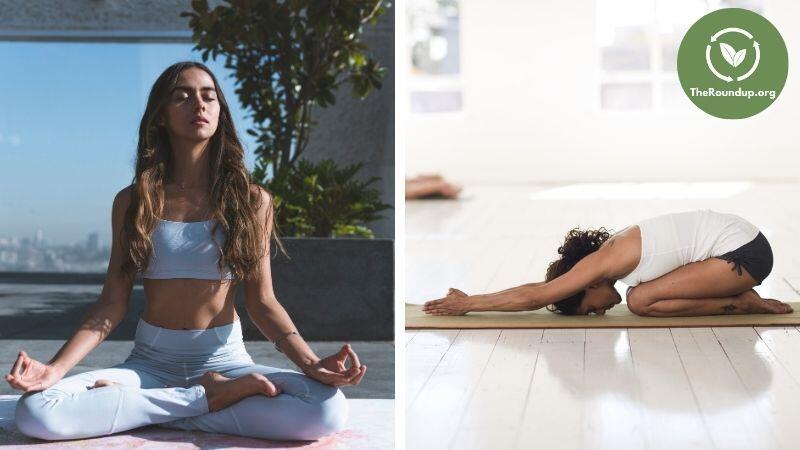
Cork, eco-foam, and natural rubber are all good choices for environmentally friendly yoga mats. Your ideal choice depends on your needs and priorities.
Rubber yoga mats can be better for the environment, depending on the type of rubber used and how it is produced. There is a big difference between natural and synthetic rubber.
Natural rubber, which is made from the sap of rubber trees, is a renewable resource and is biodegradable. Some mats are even made from recycled rubber, which can help to reduce waste.
However, synthetic rubber, which is derived from petrochemicals, is bad for the environment. The manufacturing process used to produce synthetic rubber mats can also be energy-intensive and involve the use of harsh chemicals.
Natural resin that has been sustainably harvested is not bad for the environment. Synthetic resins can contain many chemicals and are much more questionable.
Some non-chlorinated types of vinyl (EVA, PEVA, PVA, PVB) are starting to make their way to market. Being chlorine-free is great, but that on its own doesn’t make them free of toxins. If possible, I would steer clear of all vinyl to be on the safe side.
Thermoplastic Rubber (TPR) has characteristics of both rubber and plastic. It has inherent low toxicity and meets medical and food contact regulations.
Standard silicone is not the most environmentally friendly material on the market. Its production consumes non-renewable resources (such as petroleum).
When researching and testing various yoga mat options for this article, it soon became clear that you can have it all… provided you’re prepared to pay an extra few bucks and steer clear of PVC and other toxic plasticizers.
Whatever you’re looking for regarding padding, material, size, etc., there is a non toxic yoga mat out there to help you on your sustainability journey.
Every yoga mat in this article is completely free from harmful chemicals, AND either recyclable or compostable.
Namaste!
What’s your yoga mat of choice? Do most people in your class use a yoga mat made from natural materials, or are there standard mats in every corner of the room?
Drop me a line and let me know.

Our core values mean we always prioritize sustainability over profit. We carefully evaluate and personally test every product to ensure they meet our high standards. All products recommended in this article were tested in accordance with our Review Methodology.
TheRoundup.org - As Seen On
